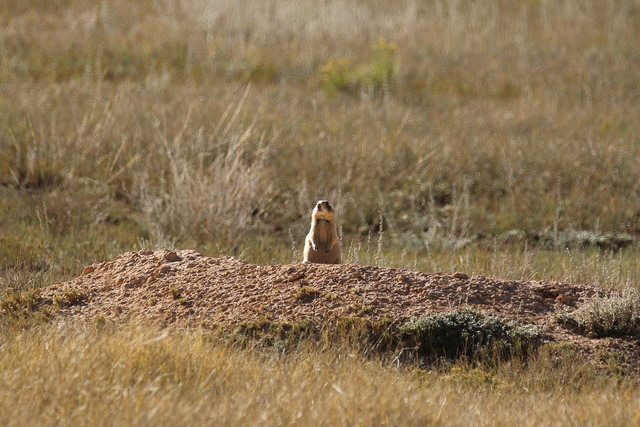Photo courtesy of Donald Hobern.
Proposals for reforming the Endangered Species Act to rely more on state regulation and private incentives are usually met by skepticism from many who doubt that states would protect species. This week, for instance, I and the Institute for Justice’s Sheldon Gilbert got into a twitter debate with Slate‘s Mark Joseph Stern on the consequences of eliminating, or even changing, the Endangered Species Act. Here’s a taste of that debate:
If successful, this would quickly lead to the extinction of many species, as state protections are almost always weaker than federal protections. But there are many wealthy donors who would like to develop protected land inhabited by endangered species. So it’s a top priority.
— Mark Joseph Stern (@mjs_DC) January 8, 2018
It’s an interesting case study and cautionary tale. But there are many ESA species that receive little or no protection from the states in which they reside. What of them? I fear the prairie dog case is being used as pretext to attack a law that is generally working well.
— Mark Joseph Stern (@mjs_DC) January 8, 2018
Recovering species is extremely popular. If environmentalists focused more of their considerable political might at the state level, states would have a strong incentive to experiment (as Utah has) and develop better ways to recover species. https://t.co/4fVjhxR7Sm
— Jonathan Wood (@Jon_C_Wood) January 8, 2018
This exchange arose because, on Monday, the Supreme Court announced that it would not hear People for the Ethical Treatment of Property Owners’ challenge to a federal regulation that forbade Utahns from using their property in ways that most of us take for granted in our own communities, prohibiting, for instance, people from building homes, starting businesses, and protecting public parks, airports, and a cemetery from a disruptive, tunneling rodent. [Disclaimer: I represent People for the Ethical Treatment of Property Owners in that challenge.]
Although the case won’t reach the nation’s highest court, it has already proved significant to endangered species policy. Four years ago, a federal court issued a decision declaring the regulation unconstitutional(that decision, which was overturned on appeal, is what the Supreme Court was being asked to review). As a result of that decision, the federal government had no authority to enforce the Endangered Species Act, as applied to the Utah prairie dog, for more than 2 years. The species’ protection was trusted solely to the state and no one could force the state to do anything.
This was the first time since the Endangered Species Act was enacted in 1973 that a state was completely free to decide what to do about endangered species, without federal interference. Stern suggests that he would expect a state to do nothing in these circumstances and for the species to suffer.
But what actually happened? Utah spent $400,000 to improve prairie dog habitat on state conservation lands. It also directed the state wildlife agency to begin moving prairie dogs from developed areas (which could not provide a long-term home for the species) to these improved conservation lands. The decades of conflict that had been generated by the federal regulation gave way to cooperation and true conservation. Utah’s efforts also achieved impressive conservation results, with the two years of state management leading to the two highest annual population surveys on record
Why would one of the reddest states in the country invest so much time and effort into conserving the Utah prairie dog when the federal government was powerless? As my response to Stern suggests, I don’t think this is surprising at all. Voters overwhelmingly support conserving endangered species, including large majorities of Republicans. What state politician in her right mind would ignore that kind of popular sentiment?
The debate over endangered species is largely about how to protect them, not whether to do so. There are significant disagreements about the best approach. Thus, one of the primary benefits of reforming the Endangered Species Act to give states a greater role is that they would be free to experiment with novel ways to recover species, increasing our knowledge of what works and what doesn’t. As it stands now, we have a one-sized fits all approach imposed by the federal government (which many critics point out has achieved a recovery rate less than 2%).
Stern is right that many states do not have strong, innovative programs to protect species. But, as Utah’s response to the district court decision striking down the federal regulation shows, that’s not because states are disinterested in the issue. Rather, it’s because the Endangered Species Act largely forbids states from innovating. Because federal law defines “take” so broadly, almost anything a state might attempt would be a federal crime. The Utah prairie dog regulation, for instance, made it a crime for state biologists to move Utah prairie dogs from backyards, playgrounds, and other residential areas to state conservation lands that had been set aside for the species’ protection. Little surprise that most states would rather cede the issue to the federal government than pursue experiments that might lead to lawsuits and, potentially, criminal liability for state employees.
As the Utah prairie dog case shows, states are willing to take on this issue when given the opportunity to do so. There’s no counter-example to suggest that a state would not step up if given a similar opportunity. In fact, several other states have shown their commitment to preserving species through innovative policies, by proactively working with environmentalists, property owners, and regulators to develop plans to conserve species before they can be listed under the federal statute. That development, which the Obama administration deserves a lot of credit for promoting, further shows that states have an interest in protecting species when given the chance to do so.
The Utah prairie dog story may yet have a happy ending, despite the Supreme Court’s decision. Based on the success of Utah’s efforts, the U.S. Fish and Wildlife Service has proposed a new federal conservation plan that would allow the state to resume its work to recover the species. That is a significant change for an agency that ignored state and local concerns for decades while inflexibly enforcing the federal Utah prairie dog regulation. And it only happened because a federal court gave Utah the opportunity to experiment. More states should have that chance.




